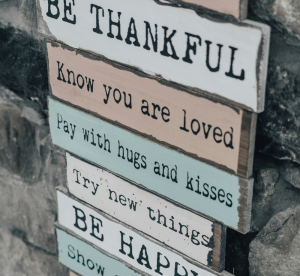How to Sit With Uncomfortable Emotions
Uncomfortable emotions suck. Anger, shame, grief, fear… they hit hard and often show up uninvited. But pretending they’re not there? That only makes it worse.
We weren’t meant to suppress our feelings or smile our way through suffering. We’re meant to feel deeply, honestly, fully. Sitting with our emotions, instead of shoving them aside, is how we start to heal. It’s how we build resilience, get to know ourselves, and grow into people who can hold space for both the light and the dark.
So if you’ve ever felt overwhelmed by your emotions—or judged yourself for feeling “too much”—this one’s for you.
Avoiding vs. Allowing
Emotional avoidance and emotional allowance may look similar on the surface, but they couldn’t be more different underneath.
Avoiding Looks Like:
- Stuffing it down.
- Distracting yourself.
- Telling yourself you’re “fine” when you’re clearly not.
- Overworking, binge-watching, numbing out with food, or scrolling.
It’s about control. Escape. Pretending.
But guess what? Emotions don’t disappear just because you ignore them. They pile up, and eventually they’ll explode—or worse, quietly drain you.
Allowing Looks Like:
- Noticing what you’re feeling.
- Letting it exist without judgment.
- Sitting with it instead of solving it.
- Breathing through it, not bulldozing over it.
It’s the difference between “I shouldn’t feel this way” and “This is what I’m feeling, and that’s okay.”
One keeps you stuck. The other sets you free.
You’re Allowed to Feel What You Need to Feel
You don’t need to justify your emotions. You don’t need a reason that makes sense to everyone else.
You’re allowed to feel angry, sad, overwhelmed, exhausted, and even numb.
You’re allowed to be soft when the world tells you to be strong.
You’re allowed to fall apart without making it poetic.
Your emotions are not a problem to be fixed. They’re a signal. A message. A part of you that’s begging to be heard.
So let them speak. You’re safe here.
How to Sit With Uncomfortable Emotions
1. Name It Honestly
Call it what it is: “I feel hurt.” “I feel embarrassed.” “I feel lonely.”
Naming the emotion gives it a shape. It becomes something you can face, not something that controls you from the shadows.
2. Tell Yourself It’s Okay
Say it out loud: “This is hard. But it’s okay to feel this.” You’re not weak. You’re human.
3. Find It in Your Body
Is your chest tight? Stomach in knots? Shoulders tense? Your body holds clues. Let it ground you in the moment.
4. Pause Before You React
Breathe. Just for a second. You don’t have to fix it or explain it. Just be with it.
5. Stay Curious, Not Critical
Ask: What triggered this? What is this emotion trying to tell me? Listen like you would to a hurting friend.
6. Try the 90-Second Rule
Most emotions peak and pass in about 90 seconds. If you can sit through the wave without grabbing onto the story, it’ll soften.
7. Choose a Safe Space
That might be your bed, the woods, a long drive, or a sketchbook. Emotions move more freely when you’re not in survival mode.
8. Let It Be Messy
Don’t force a lesson or a silver lining. Sometimes, survival is the lesson.
9. Speak Kindly to Yourself
Say: “I’m here.” “I don’t have to fix this right now.” “I’m doing the best I can.”
This is emotional first aid.
10. Let the Emotion Finish
Emotions have a beginning, middle, and end. Let it rise. Let it crest. Let it pass.
11. Move Your Body If You Need To
Stretch. Walk. Shake it out. Sometimes your body needs to process what your mind can’t.
12. Set a Timer for Contained Feelings
If it’s too much, set a 5 or 10-minute timer. Sit with the feeling until it dings. Then step back. Repeat if needed.
13. Journal the Unfiltered Truth
Don’t edit. Don’t prettify it. Let the page hold what your heart can’t yet say aloud.
14. Reach Out (Even Quietly)
Send a message to someone safe. You don’t need to spill everything. Sometimes just saying, “Hey, I’m struggling,” is enough.
15. Know That This Is a Skill
It’s not weakness. It’s not failure. Sitting with your emotions is a brave, sacred skill. You’re not behind. You’re just learning.
How to Tell If You’re Emotionally Avoiding
- You’re always busy or distracted
- You downplay your emotions or tell yourself to “get over it.”
- You avoid people or places that stir up feelings
- You’re numb with food, social media, alcohol, work, etc.
- Stillness makes you restless or anxious
- You overthink instead of feel
- You disconnect emotionally
- You delay decisions to avoid emotional consequences
- You react impulsively to dodge discomfort
- You keep promising yourself: I’ll deal with this later…
Sound familiar? You’re not alone. And the good news? Avoidance is just a habit. You can unlearn it.
When It Feels Too Overwhelming
If the feelings get too loud, don’t try to fix everything at once. Focus on one breath, one step, one small act of care.
Try This:
- Take a deep breath. Just one.
- Do one thing: drink water, stretch, tidy one corner.
- Ground yourself: touch something cold, name 5 things you see.
- Break things down into tiny, doable tasks.
- Say to yourself: “This will pass.”
- Text someone. Let yourself be seen.
- Lower the bar. Good enough is enough today.
- Rest without guilt. You are not a machine.
- Use calming phrases: “I am safe.” “I can do this.” “One step at a time.”
- And if it’s too much, reach out. You deserve support. Always.
Final Words
You don’t have to like your emotions.
You don’t have to explain them, justify them, or make them inspiring.
You just have to let them be.
That’s how they pass through instead of taking root.
You are not broken for feeling deeply.
You are not dramatic for being honest.
You are simply, beautifully human.
And that is more than enough ♥





